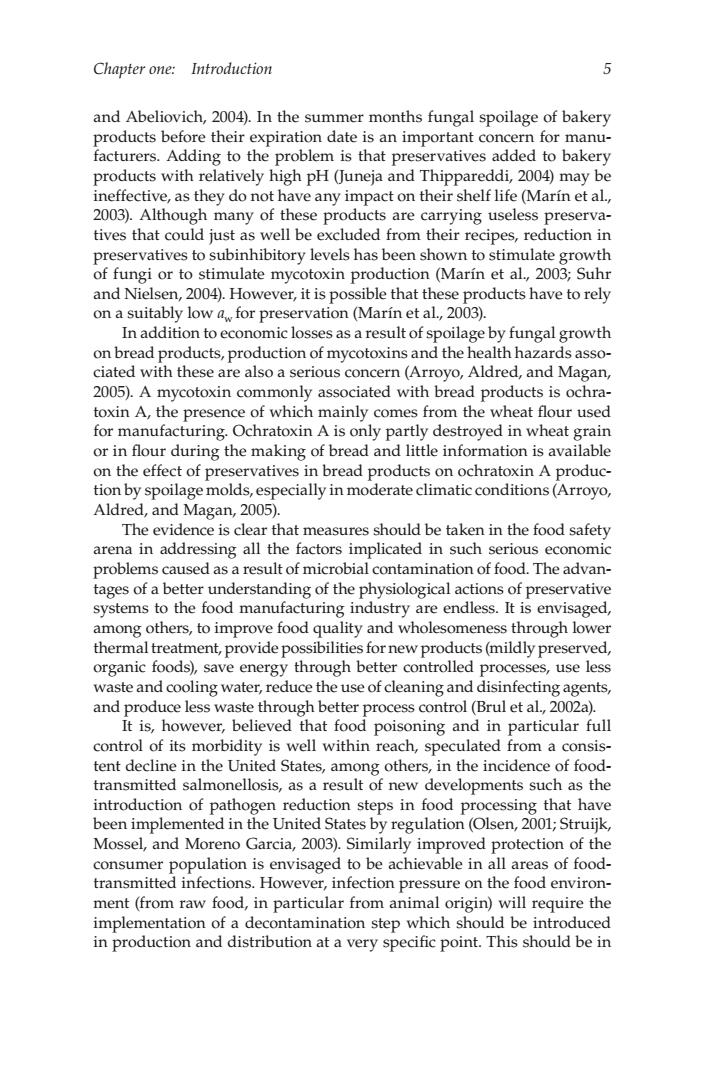正在加载图片...

Chapter one:Introduction 5 and Abeliovich,2004).In the summer months fungal spoilage of bakery products with relatively high pH (Juneja and Thippareddi,2004)may be ineffective,as they do not have any impact on their shelf life(Marin et al., 2003).Although many of these products are carrying useless preserva- tives that could just as well be excluded from their recipes,reduction in ervatives to subinhibitory levels has be een sh or to alate myco oxin pro (Marin et and Nielsen,2004).However,it is possible that these products have to rely on a suitably low a for preservation(Marin et al.,2003). In addition to economic losses as a result of spoilage by fungal growth on bread products,production of mycotoxins and the health hazards asso- ciated with these are also a serious concern(Arroyo,Aldred,and Magan, 2005).A mycotoxin commonly associated with bread products is ochra- toxin A,the nufac pre of wh come r the r us Ochratoxin A d in wheat or in flour during the making of bread and lteinformationisava le on the effect of preservatives in bread products on ochratoxin A produc- tion by spoilage molds,especially in moderate climatic conditions(Arroyo, Aldred,and Magan,2005). The evidence is clear that measures should be taken in the food safety arena in addressing all the factors implicated in such serious economic proble aused as a re sult of mi ation of food.The ady tages of a ing of the physic ological a f preservativ systems to the food mant is envisaged among others,to improve food quality and wholesomeness through lower thermal treatment,provide possibilities for new products(mildly preserved, organic foods),save energy through better controlled processes,use less waste and cooling water,reduce the use of cleaning and disinfecting agents, and produce less waste thre ough bette is ho tha weve ·f and in control of lity is well within rea oning a particular full h,spec rom a c ns tent decline in the United States,among others,in the incidence of food transmitted salmonellosis,as a result of new developments such as the introduction of pathogen reduction steps in food processing that have been implemented in the United States by regulation(Olsen,2001;Struijk, Mossel,and Moreno Garcia,2003).Similarly improved protection of the consumer population is envisaged to be achievable in all areas of food- transmitted infections.How infection pr on the food envi ment(from raw food in particula from anim origin will require the nentation of decontamination step which shou ld be intre in production and distribution at a very specific point.This should be in Chapter one: Introduction 5 and Abeliovich, 2004). In the summer months fungal spoilage of bakery products before their expiration date is an important concern for manufacturers. Adding to the problem is that preservatives added to bakery products with relatively high pH (Juneja and Thippareddi, 2004) may be ineffective, as they do not have any impact on their shelf life (Marín et al., 2003). Although many of these products are carrying useless preservatives that could just as well be excluded from their recipes, reduction in preservatives to subinhibitory levels has been shown to stimulate growth of fungi or to stimulate mycotoxin production (Marín et al., 2003; Suhr and Nielsen, 2004). However, it is possible that these products have to rely on a suitably low aw for preservation (Marín et al., 2003). In addition to economic losses as a result of spoilage by fungal growth on bread products, production of mycotoxins and the health hazards associated with these are also a serious concern (Arroyo, Aldred, and Magan, 2005). A mycotoxin commonly associated with bread products is ochratoxin A, the presence of which mainly comes from the wheat flour used for manufacturing. Ochratoxin A is only partly destroyed in wheat grain or in flour during the making of bread and little information is available on the effect of preservatives in bread products on ochratoxin A production by spoilage molds, especially in moderate climatic conditions (Arroyo, Aldred, and Magan, 2005). The evidence is clear that measures should be taken in the food safety arena in addressing all the factors implicated in such serious economic problems caused as a result of microbial contamination of food. The advantages of a better understanding of the physiological actions of preservative systems to the food manufacturing industry are endless. It is envisaged, among others, to improve food quality and wholesomeness through lower thermal treatment, provide possibilities for new products (mildly preserved, organic foods), save energy through better controlled processes, use less waste and cooling water, reduce the use of cleaning and disinfecting agents, and produce less waste through better process control (Brul et al., 2002a). It is, however, believed that food poisoning and in particular full control of its morbidity is well within reach, speculated from a consistent decline in the United States, among others, in the incidence of foodtransmitted salmonellosis, as a result of new developments such as the introduction of pathogen reduction steps in food processing that have been implemented in the United States by regulation (Olsen, 2001; Struijk, Mossel, and Moreno Garcia, 2003). Similarly improved protection of the consumer population is envisaged to be achievable in all areas of foodtransmitted infections. However, infection pressure on the food environment (from raw food, in particular from animal origin) will require the implementation of a decontamination step which should be introduced in production and distribution at a very specific point. This should be in